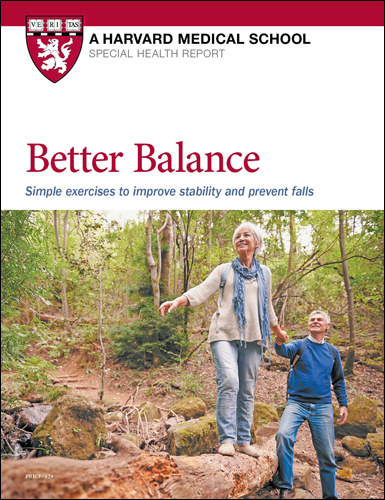
Hemoglobin A1c (HbA1c): What to know if you have diabetes or prediabetes or are at risk for these conditions

What could be causing your blurry vision?

Avocado nutrition: Health benefits and easy recipes

Swimming lessons save lives: What parents should know

Preventing and treating iliotibial (IT) band syndrome: Tips for pain-free movement

Wildfires: How to cope when smoke affects air quality and health

What can magnesium do for you and how much do you need?

Dry socket: Preventing and treating a painful condition that can occur after tooth extraction

What happens during sleep — and how to improve it

How is metastatic prostate cancer detected and treated in men over 70?


Core Exercises: 6 workouts to tighten your abs, strengthen your back, and improve balance
Want to bring more power to athletic pursuits? Build up your balance and stability? Or are you simply hoping to make everyday acts like bending, turning, and reaching easier? A strong, flexible core underpins all these goals. Core muscles need to be strong, yet flexible, and core fitness, like that found in the Special Health Report Core Exercises: 6 workouts to tighten your abs, strengthen your back, and improve balance, should be part of every exercise program.
Other Product Information
Want to bring more power to athletic pursuits like running, swimming, golf, and tennis? Ward off or ease lower back pain? Build up your balance and stability so that you’re less likely to fall? Do you dream of running a marathon, or flashing washboard abs at the beach? Or are you simply hoping to make everyday acts like bending, turning, and reaching easier so that housework, fix-it projects, and gardening stay on your agenda? A strong, flexible core underpins all these goals.
Your core — which includes back, side, pelvic, and buttock muscles — forms a sturdy central link between your upper and lower body. Much like the trunk of a tree, core muscles need to be strong, yet flexible. A weak or inflexible core impairs how well your arms and legs function, draining power from many of the moves you make. For these reasons, core fitness should be part of every exercise program.
In this report, you’ll learn ways to slip these essential exercises into even the busiest schedule. The six core workouts in this report feature exercises that emphasize moves you make during sports and everyday life. We’ll show you how to set achievable goals and work smart, rather than wasting time you’d rather spend elsewhere. Twenty to 40 minutes a few times a week — or even just five minutes a day — is all the time you need. We’ve skipped standard crunches in favor of more challenging exercises designed to buff more than one muscle group at a time. And all of the exercises can be made easier or harder, depending on your current level of core fitness.
This Special Health Report was prepared by the editors of Harvard Health Publishing in consultation with Medical Editor Lauren E. Elson, M.D., Physical Medicine and Rehabilitation Instructor at Harvard Medical School, and Fitness Consultant Michele Stanten, Certified Fitness Instructor at the American Council on Exercise. 53 pages. (2020)
Posture, alignment, and angles: Striking the right pose
Posture counts a lot when you’re exercising. Aligning your body properly is the key to good form, which nets you greater gains and fewer injuries. In fact, good posture helps anytime you’re moving. If one foot is always turned slightly inward, for example, it impedes power whether you’re walking, going upstairs, jogging, or playing sports. Worse, it paves the way for injuries to the ankle, knee, hip, and beyond, since the effects of this physical quirk can zigzag their way up your body. Similarly, sitting up straight and comfortably aligned in a chair can make desk work feel less tiresome. Hours of computer and desk work tend to make your shoulders hunch and your head and neck jut forward uncomfortably.
Committing to core work will do much to improve your posture whether you’re sitting, standing, or moving. A balance of core exercises, such as those selected for our workouts, is best. If you only pour your efforts into strengthening abs, your back muscles will grow weaker by comparison. Instead of standing up straight, your body will curve forward. Likewise, posture is thrown out of kilter when muscles lose flexibility, becoming tighter and eventually shortening so that your range of motion is increasingly limited. Among other problems, this can cause back pain.
Our workouts are designed to build strength and flexibility in all your major core muscles. Doing any of our full workouts, or the four great moves in our short workouts, can help you avoid such problems.
Posture checks
Quick posture checks before and during exercise can help you avoid injury and squeeze the most benefit from your workout. If possible (mainly when doing standing exercises), look in a mirror from time to time. Try to take a few moments each day to practice better posture, too. When exercise instructions in our workouts ask you to stand up straight, that means the following:
- chin parallel to the floor
- shoulders back and down
- arms at your sides, elbows relaxed
- abdominal muscles pulled in
- knees even and pointing straight ahead
- feet pointing straight ahead
- body weight evenly distributed on both feet.
Stay neutral
Whether you’re standing or seated, neutral posture requires you to keep your chin parallel to the floor; your shoulders, hips, and knees at even heights; and your knees and feet pointing straight ahead.
A neutral spine takes into account the slight natural curves of the spine—it’s not flexed or arched to overemphasize the curve of the lower back. One way to find neutral is to tip your pelvis forward as far as is comfortable (lifting your tailbone up), then tip it backward (tucking your tailbone under) as far as is comfortable. The spot approximately in the middle is neutral. If you’re not used to standing or sitting up straight, it may take a while for this to feel natural.
A neutral wrist is firm and straight, not bent.
Neutral alignment means keeping your body in a straight line from head to toe except for the slight natural curves of the spine.
Get the angle
When angles appear in exercise instructions, use these tips. Try visualizing a 90° angle as an L or two adjacent sides of a square, or picture the distance between the minute hand and hour hand of a clock at 3 o’clock. To visualize a 45° angle, mentally slice the 90° angle in half.
- The importance of your core
- Why strengthen your core?
- Major core muscles
- Beyond muscles
- Before you start: Safety first
- When to check with a doctor first
- 12 tips for exercising safely and effectively
- Posture, alignment, and angles: Striking the right pose
- Getting started
- Which workout should you do?
- How does core work fit into your exercise plans?
- Finding the time
- The right stuff: Choosing equipment
- Terminology used in the workouts
- Measuring gains
- Standing core workout
- Floor core workout
- Pilates
- Medicine ball workout
- Stability ball workout
- Bosu workout
- Finish with stretches
- Special Bonus Section: Setting goals and motivating yourself, and maintaining gains
- Improve your game
- Resources
- Glossary
You might also be interested in…

Better Balance: Simple exercises to improve stability and prevent falls
Discover how you can prevent falls by improving your balance and mobility. Better Balance: Simple exercises to improve stability and prevent falls gives you step-by-step instructions for easy, effective workouts that will improve posture, increase muscle strength and speed, sharpen reflexes, expand flexibility, and firm your core. You'll also get tips for fall-proofing your home.

Hemoglobin A1c (HbA1c): What to know if you have diabetes or prediabetes or are at risk for these conditions

What could be causing your blurry vision?

Avocado nutrition: Health benefits and easy recipes

Swimming lessons save lives: What parents should know

Preventing and treating iliotibial (IT) band syndrome: Tips for pain-free movement

Wildfires: How to cope when smoke affects air quality and health

What can magnesium do for you and how much do you need?

Dry socket: Preventing and treating a painful condition that can occur after tooth extraction

What happens during sleep — and how to improve it

How is metastatic prostate cancer detected and treated in men over 70?
Free Healthbeat Signup
Get the latest in health news delivered to your inbox!
Sign Up

